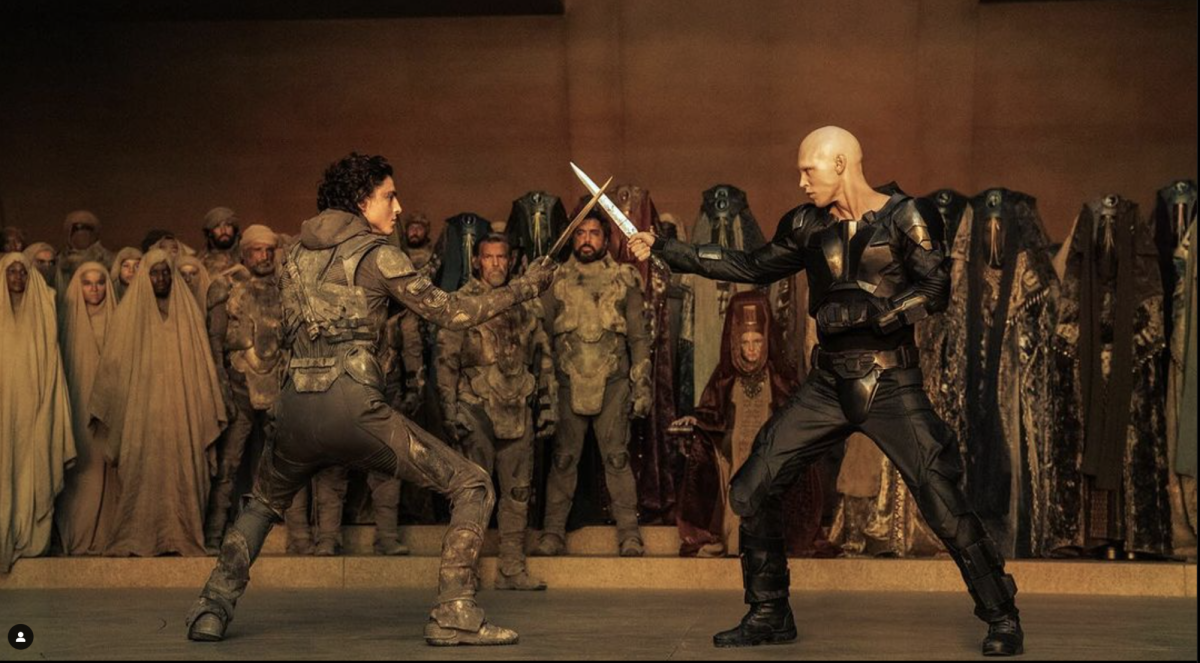When one’s destiny is to rule their people, one won’t quit until it has been achieved.
That’s what Paul Atreides, played by Timothee Chalamet, must decide in this two part epic that is still unfolding with another part of the soon to be trilogy on its way.
My background on the DUNE franchise is lacking because I only got into it with the newest adaptation from 2021. The franchise began with a series of books, eventually leading to the 1984 movie adaptation from David Lynch and then to “Children of Dune,” a TV mini series starring James McAvoy from 2003.
Picking up immediately from the 2021 film, the suspense heightens quickly and does not hold anything back. With the camera mainly focusing on far and wide shots in the dense and humid environment of the dunes, rushes of adrenaline will hit you hard as you watch the sequences unfold in the opening scenes. The director, Denis Villeneuve, stepped up his game from the first film to truly capture the movement and living qualities of the characters in the desert.
The film doesn’t waste your time by reintroducing everything but rather respects the audience’s intelligence. This is basically their version of “The Empire Strikes Back” within the soon to be trilogy.
The main aspect that stood out to me throughout the film was character growth. Most characters go through change or experience changes around them, further enhancing their capabilities and raising the bar for how far they’ve gone to reach their goals. The character that I thought experienced the most changes was Paul Atreides.
Paul slowly made his way up the ladder, from doubting himself for following in his father’s footsteps, to coming to his own terms and realizing his true potential. By breaking away from his original idea of being his father’s predecessor, Paul now realizes that he can do so much more. Paul’s growth from the first film to this one was immense and important. Once a self-judging and insecure person to someone who has everyone looking up to him, not just as a leader but a savior, which is noteworthy in and of itself. With every good leader or religious figure there is always one downside or trait that follows them, and for Paul, it’s his desperate hunger for power. The further he goes on the path he’s following, for everything good he’s committing to, he slowly loses himself in a power hungry struggle.
Florence Pugh’s performance in the film, although quite small, is all encompassing, as it should be since she is the daughter of the emperor after all. Pugh gives off a strong sense of empowerment that I think the emperor, played by Christopher Walken, didn’t quite have on screen. Having a high status on her shoulders, she also carried the slightest hint of worry, never knowing what could happen between her father and her people. She also brings a lot of emotional weight when it comes to her facial expressions as she’s able to say so much without speaking. From her surprised nature to the short but sweet smiles, it all makes for a more dramatic but beautiful look to the film.
Austin Butler’s performance in the film is also quite interesting. Not only is he another new addition to the already large list of characters, but he brings a vibe like no other. When we first meet his character, the color grading changes from vibrant and bright to a black and white scheme, giving off a sinister look to his character and many others. I previously mentioned facial expressions and how Pugh did an excellent job yet it is Butler, however, who takes it above and beyond my expectations. The way he brought some of his sinister expressions had the same effect as Azog did from “The Hobbit” trilogy, especially when he was a fully CG rendered character. I personally think he outperformed Dave Bautista and Stellan Skarsgard, who were in the same boat as him, playing another role as members of the family.
Timothee Chalamet’s performance in this film is a far step ahead from where he was originally in the first film, showing what he is capable of as an actor. This is most evident towards the later acts of the film.
Chalamet brings a lot of charm to the role as Paul, allowing the audience to connect with him as he taps into a leadership role which the audience may be able to relate to. He takes the emotional status that Paul has from the first film to a whole new level in this second film. Having previously had more of a laid back focus to his character, even though he’s the heart of both films, he pushed the limits this time as he breaks that barrier and becomes the leader he was meant to be.
At the end of the day, DUNE: PART TWO is a phenomenal piece of cinema that we don’t get all that often. To see this film on the big screen, even if it’s not on IMAX, is still a beauty of a film to look at, thanks to Greig Fraser, the cinematographer. Would I recommend this film to the general audience? No, as it is a slow burner, mainly focusing on heavy character development, but when it comes to pure film lovers, this shouldn’t be overlooked.
“Dune: Part two”: A slowburn and full of character(s)
Logan Olson, Multimedia Editor
March 19, 2024
Despite delays, “Dune: Part 2 released March 1 this year. It’s been very well received by critics and audiences getting a 92% critic score and 95% audience score on rotten tomatoes, as well as a 8.9 on IMDB, at time of writing.
0



















